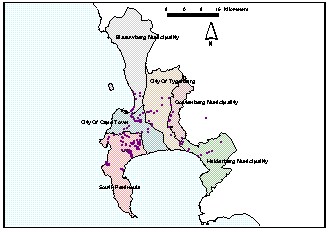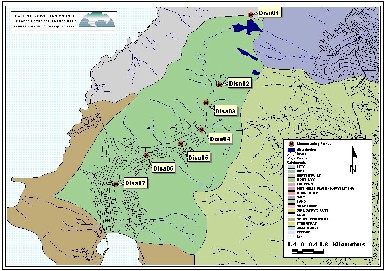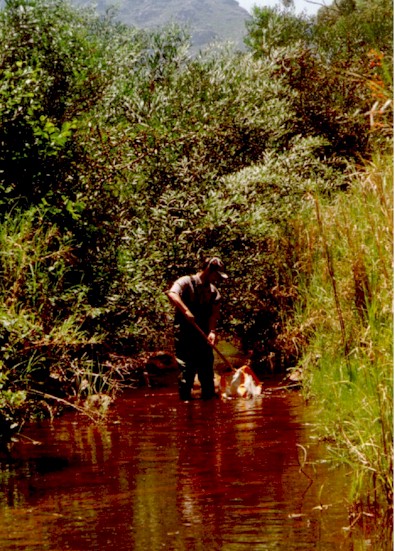
|
RHP |
South African
River Health Programme |

|
 |
|
Water quality monitoring in rivers, vleis and dams of Cape Town and surrounding areas has, for many years, been the responsibility of the Scientific Services Department of the local authority (now called the Cape Metropolitan Council). An extensive historic record of chemical, algal and bacteriological data thus exists for somewhere in the region of 150 monitoring stations. Few biological or ecological studies were however conducted in the early years - most work of this nature tending to focus on the status of certain vleis. Figure 1 gives a broad indication of the location of approximately 120 monitoring stations that are currently sampled in the 6 metropolitan local councils of the “Cape Metropolitan Area”.  In recent years, the importance of the ecological status of these surface water systems has been recognized and detailed studies conducted by freshwater ecologists, university students and consultants have contributed to our understanding of the health of our rivers and vleis. Many of these studies have utilized biological monitoring methodologies. The advent of the National River Health Programme (RHP) has provided organizations working within the water sector around South Africa with a framework to formally introduce such biomonitoring techniques within their particular monitoring programmes. In 1999, the Cape Metropolitan Council (CMC) proposed to implement a local River Health Programme to supplement and compliment its existing water quality monitoring programme. By the end of 1999 / early 2000 a number of preliminary surveys had been successfully completed on the Diep – Mosselbank, Salt, Sand and Disa Catchments. Due to a small staff compliment in Scientific Services’ Hydrobiology section, it has been decided that biomonitoring surveys will initially only be repeated once a year in the Cape Metro Area’s major catchments. In addition to the SASS4 and IHAS indices, testing of the newly developed RVI will be undertaken. It is envisaged that the use of this index within a predominately urban context will yield some interesting results! A Water Quality Index developed for the area will also undergo testing during the 2000 / 2001 biomonitoring period. Data generated by the CMC’s River Health Programme will be stored in our Monitoring Information System (MONIS) which is to be linked to the Rivers Database. A “State of the River” report will be compiled following each detailed survey, and the main findings and recommendations will be communicated to our local catchment forums. Summarized RHP results are also reported in annual “State of the Environment” reports (compiled by the CMC’s Environmental Management Department). It is hoped that our data will also prove valuable in setting resource quality objectives for our urban catchments. Some challenges that face us include the fact that the Cape Metro Area is small when viewed in the context of the Western Cape’s RHP initiative. The level of detail required by the local authority is however high – thus no matter where one’s biomonitoring efforts are focussed, one always finds that there is plenty of enthusiasm but just too few hands…. Another difficulty in the Cape Metro Area is the fact that many of our rivers have unfortunately been canalized. In fact, biomonitoring within an urban context can prove very difficult as the biomonitoring methodologies are not always suited to concrete or earth-lined canals! The CMC’s local programme falls under the umbrella of the Western Cape’s RHP initiative. Regular communication with the provincial champion and other biomonitoring practitioners has proved valuable and it is envisaged that the CMC’s biomonitoring contingent will also assist the Provincial Implementation Team (PIT). An exciting partnership between Umgeni Water and the CMC will soon see our environmental education personnel introducing miniSASS (an internet-enabled educational resource) to schools in the Cape Metro Area. It is envisaged that “red flags” raised by miniSASS will also be monitored as part of the CMC’s River Health Programme. 

|
Candice Haskins Jonkershoek 27 October 2000 |
|
|